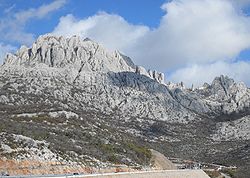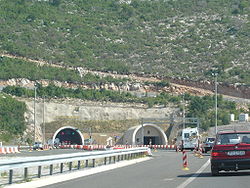
Sveti Rok Tunnel
Encyclopedia


Tunnel
A tunnel is an underground passageway, completely enclosed except for openings for egress, commonly at each end.A tunnel may be for foot or vehicular road traffic, for rail traffic, or for a canal. Some tunnels are aqueducts to supply water for consumption or for hydroelectric stations or are sewers...
in Lika
Lika
Lika is a mountainous region in central Croatia, roughly bound by the Velebit mountain from the southwest and the Plješevica mountain from the northeast. On the north-west end Lika is bounded by Ogulin-Plaški basin, and on the south-east by the Malovan pass...
, Croatia
Croatia
Croatia , officially the Republic of Croatia , is a unitary democratic parliamentary republic in Europe at the crossroads of the Mitteleuropa, the Balkans, and the Mediterranean. Its capital and largest city is Zagreb. The country is divided into 20 counties and the city of Zagreb. Croatia covers ...
. It is 5679 m (6,211 yd) long and it passes through the Velebit
Velebit
Velebit is the largest though not the highest mountain range in Croatia. Its highest peak is the Vaganski vrh at 1757 m.The range forms a part of the Dinaric Alps and is located along the Adriatic coast, separating it from Lika in the interior...
mountain. Sveti Rok Tunnel is located on a part of the between highway exits Sveti Rok
Sveti Rok
Sveti Rok is a small village in the Lovinac municipality, in Lika–Senj County, Croatia. Sveti Rok has a population of 292. The majority of the population are Croats....
and Maslenica
Maslenica
Maslenica is a port and village in Zadar County, Dalmatia, Croatia.Its geographical coordinates are 44°13'N, 15°32'E. It is situated in Novigrad Sea, the gulf of Novigrad. Waters are quite clear due to the Zrmanja river which flows into this gulf.- History :...
on the A1 highway
A1 (Croatia)
The A1 motorway is the longest motorway in Croatia spanning . As it connects Zagreb, the nation's capital, to Split, the second largest city in the country and the largest city in Dalmatia, the motorway represents a major north–south transportation corridor in Croatia and a significant part of the...
(Zagreb
Zagreb
Zagreb is the capital and the largest city of the Republic of Croatia. It is in the northwest of the country, along the Sava river, at the southern slopes of the Medvednica mountain. Zagreb lies at an elevation of approximately above sea level. According to the last official census, Zagreb's city...
- Split
Split (city)
Split is a Mediterranean city on the eastern shores of the Adriatic Sea, centered around the ancient Roman Palace of the Emperor Diocletian and its wide port bay. With a population of 178,192 citizens, and a metropolitan area numbering up to 467,899, Split is by far the largest Dalmatian city and...
). The village Sveti Rok
Sveti Rok
Sveti Rok is a small village in the Lovinac municipality, in Lika–Senj County, Croatia. Sveti Rok has a population of 292. The majority of the population are Croats....
and town Posedarje
Posedarje
Posedarje is a municipality in Zadar County of Croatia with 3,513 inhabitants....
are located near the tunnels respective northbound and southbound entrances, but they are accessible only by highway exits. The western shaft of the tunnel was opened in on 30 June 2003, and the eastern shaft was opened on 30 May 2009.
Description
The northern portal of the tunnel is located at 561 m.a.s.l., while the southern portal is located at 510 m.a.s.l.. The east tunnel tube is slightly longer than the west one - as they are 5679 metres (18,631.9 ft) and 5670 metres (18,602.4 ft) long respectively. The tunnel tubes are executed 25 metres (82 ft) m apart, and are connected by 4 passages for vehicles and 15 other passages, accessible on foot.Since the Sveti Rok Tunnel and the Mala Kapela Tunnel are of similar lengths, and their construction has been carried out concurrently, their appearance and properties are very similar. Therefore the tunnel also comprises 7.7 metres (25.3 ft) wide carriageways, permitting driving speeds of up to 100 km/h. The tunnel features an autonomous drainage system channeling water accumulating due to tunnel cleaning, as well as any seeping water, firefighting and accidents. The tunnel is equipped with variable traffic signs in order to ensure enhanced safety of the traffic, regulated from traffic control centres along the A1 motorway. Electronic equipment of the tunnel allows use of two VHF radio frequencies (HR1 at 102.3 MHz and HR2 at 97.5 MHz) as well as cell phones. Electrical power is supplied to the tunnel via one 35 kV switching station at each end of the tunnel and 8 distribution switching stations in the tunnel itself. A backup electrical power supply is also provided to ensure continuous operation of the tunnel.
The tunnel has been executed using New Austrian Tunnelling method
New Austrian Tunnelling method
The New Austrian Tunnelling method was developed between 1957 and 1965 in Austria. It was given its name in Salzburg in 1962 to distinguish it from old Austrian tunnelling approach. The main contributors to the development of NATM were Ladislaus von Rabcewicz, Leopold Müller and Franz Pacher...
, by means of drilling and explosive blasting. Numerous caves, caverns and other speleological structures were found during constructions, but all of those were addressed successfully. 1137 metres (3,730.3 ft) of underground channels were found during construction, including a hall measuring 148 metres (485.6 ft) by 53 metres (173.9 ft) by 62 metres (203.4 ft), found at chainage 200+525. Some of the structures are of considerable length, as they appear to be connected to the surface - as inferred by presence of bats. The speleological structures encountered during the construction presented problems to construction of the tunnel, but they have been successfully preserved as natural phenomena.
Traffic volume
Traffic is regularly counted and reported by Hrvatske autoceste, operator of the bridge and the A1 motorway where the bridge is located, and published by Hrvatske cesteHrvatske ceste
Hrvatske ceste is a Croatian state-owned company pursuant to provisions of the Croatian Public Roads Act , the county and local roads are managed by county authorities, while the motorways are managed by Croatian Motorways Ltd and other concessionaires.The company is currently administered by a...
. Substantial variations between annual (AADT) and summer (ASDT) traffic volumes are attributed to the fact that the bridge carries substantial tourist traffic to the Dalmatia
Dalmatia
Dalmatia is a historical region on the eastern coast of the Adriatic Sea. It stretches from the island of Rab in the northwest to the Bay of Kotor in the southeast. The hinterland, the Dalmatian Zagora, ranges from fifty kilometers in width in the north to just a few kilometers in the south....
n Adriatic resorts. The traffic count is performed using analysis of motorway toll ticket sales.
| Sveti Rok Tunnel traffic volume | ||||
| Road | Counting site | AADT | ASDT | Notes |
| A1 | 4909 Sveti Rok south | 12,353 | 32,125 | Between Sveti Rok and Maslenica interchanges. |

